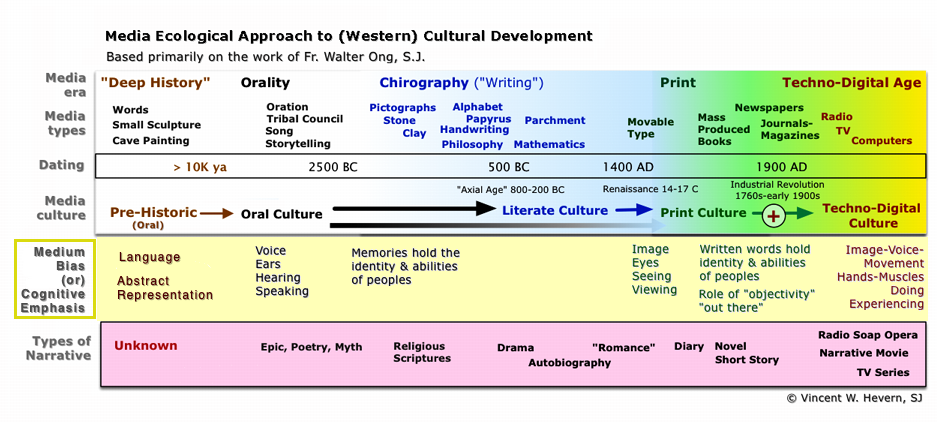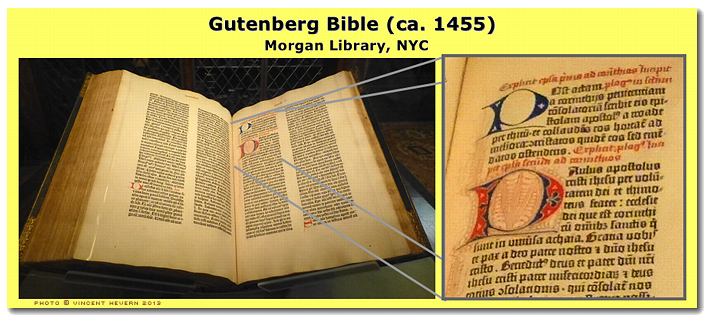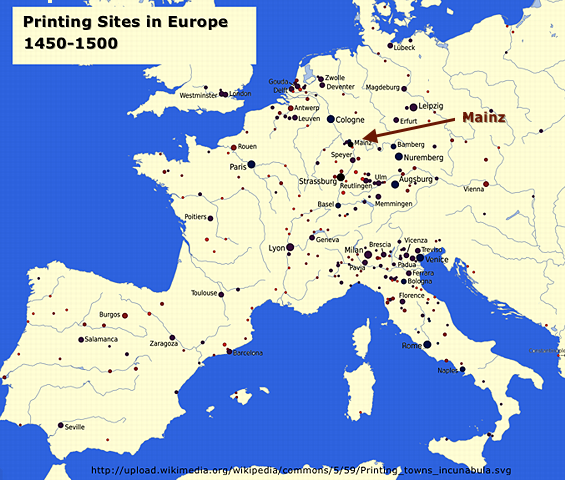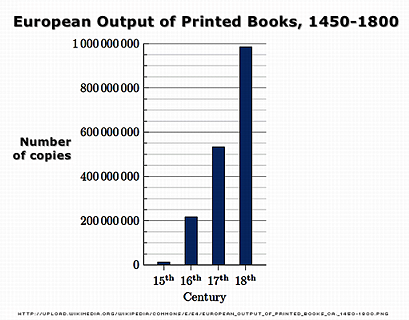PSY 355 Psychology & Media in
the Digital Age
This page was last modified on September 9, 2024
PSY 355 Psychology & Media in
the Digital Age
This page was last modified on September 9, 2024 |
The Development of Media from a Media Ecology Perspective II [OUTLINE]

The Development of Printing, the "Printing Revolution" and the Rise of Print Culture
The inventor of mechanical movable type = Johannes Gutenberg (ca. 1395-1468)
1. Individual metal letters (type)
2. An oil-based ink
3. A press
In 1454-1455, Gutenberg began to publish the famous 42-line edition of the "Gutenberg Bible". Scholars believe that he printed about 150-180 copies of this bible (about 50 complete copies are known to still be in existence). His original edition included 75% printed on paper and 25% printed on vellum. A full-size version of this bible contained 1,272 pages.



Pamphlets (by 1500)
- Newspapers (1600+) with classified ads (1622+)
- Scientific journals (1665+ Philosophical Transactions of the Royal Society)
- Periodicals (1711; The Spectator, London, published daily)
- Magazines (1731; The Gentleman's Magazine, London)
- "Broadsides" = very large sheet printed on one side, e.g, US Declaration of Independence (1776)
- The "Penny Press" = newspapers @ 1 cent a copy (1820s)
- "Penny Dreadfuls" = Serialized fictional paperback books (1830s)
- Newspapers with paid commercial advertising (1836, La Presse, France)
- Modern, mass-produced paperback books (1938, US)
The Impact of Printing & Print Culture (Ong, 1982)
Walter Ong and other media ecologists argue that the written word and printing "restructures human consciousness" in a variety of ways.
- Writing and, particularly, printing (of both texts and illustrations) emphasize what is visual and seen (concerned for the surface rather than depth)
- Printed words carry a more independent kind of existence. Hence, the printed word and illustrations emphasize objectivity to their readers.
- Contributed to the rise of the modern scientific mind and methods.
- Strong movement toward expanding literacy.
- People are freed from the need to follow very conservative pathways
- The history of a people, its beliefs, customs, and ways of living increasingly transfer to written formats. They can be "looked up" in books rather than listened to from other persons.
The Advent of the Techno-Digital Age & "Secondary Orality"
- Electricity (and steam) as a source of power
- Data moving from analog to digital formats
- Publishing
- reaches larger audiences
- in the last four decades moves from fewer large corporate organizations to include many smaller publishing entities (via "desk-top" publishing, blogs, websites, e-zines, podcasts, TikTok, YouTube, other social media, etc.)
- spread over wider and wider geographical areas
- The human sensory-perceptual and motor-expressive systems involves
- (1) hearing sound and voice once again [telephone, phonographs, records...]
- (2) experiencing dynamic visual movement [movies, TV, video-gaming...], and
- (3) using touch and personal bodily movements [employing a computer mouse or touch pad, video-gaming, on-screen responding such as 'texting,' etc.]
- (4) sensory-perceptual information beyond the realm of the human senses of hearing and seeing to include the entire electromagnetic spectrum.
- Size and distances open to human experience grow exponentially larger and smaller.
- Speed of communication is not only faster but the issue of distance becomes relatively trivial (at the magnitude of the Earth and its surface). The lag-time between sending and responding to information becomes shorter and shorter.
- The amount of information that can be stored and retrieved grows exponentially while the cost of data storage becomes exponentially cheaper. Thus storage capacity for human knowledge is virtually unlimited although retrieval capacity lags behind.
"Secondary Orality" (Ong, 1982)
- Literary culture + new forms emerging in the techno-digital age => "secondary orality"
- TV, radio, movies, CDs and recorded music, etc.
- The sacredness of or predominant role of the printed word tends to be undermined
- Movement back toward large group membership & experiences in secondary oral cultures (audiences, fan clubs, etc.).
The Development of Media as a World-Wide Ecological System
In the contemporary world, media more and more forms what can be described as a world-wide ecological system. What does this mean?
Ecology in the Natural World = biological system or network, interdependent organisms, multiple species, functioning within both environments with both living and non-living components.
Natural ecology provides a metaphor or parallel to what can be found in the world of media
Ecology in the Media World = A technological (information & communication) system (or network) of interdependent tools and methodologies (a) exhibiting a multiplicity of forms, (b) arranged in nested hierarchical fashion, (c) functioning with environments of both human and non-living physical components and (d) directed toward achieving or advancing human goals broadly conceived, e.g., communication, information acquisition & analysis, entertainment & recreation, etc.
- particular habitats, i.e., the human life world including social life spaces, cultural worlds, and the physical environment
- teenagers, college students, families, businesses, lonely singles, scientists, hobbyists, creative artists, refugees & immigrants, etc.
- specific niches, i.e., a medium's job, what it accomplishes, its role in the habitat
- social exchange, short message communication, music sharing, dating, scholarly communication, artistic production like graphic design or photography, etc.
- interfaces between the technological forms & their human users as well as between the different technological forms themselves
- Screens, microphones, earjacks, speakers, keyboards, track pads, styli (styluses), etc.
- Wifi & broadband, the Internet & its protocols, routers, ethernet outlets, etc.
- a diversity of technological forms (hardware & software)
- laptop computers, desktop computers, tablet computers, smart phones, etc.
- Gaming stations, digital cameras, inkjet printers, Bluetooth speakers, etc.
- Photoshop, Twitter, Facebook, Garage Band, YouTube, Flickr, Instagram, etc.
Some of the questions we can ask ourselves about digital media ecologies include
- What are the most important particular habitats that I live within at the present time?
- What niches do I seek out within the media ecologies available to me? What are the most important roles that media play within my life?
- Do I prefer some types of interfaces over others in the ways I live within my media ecology?
- What are the most important specific technological forms that I enjoy within my media ecology?